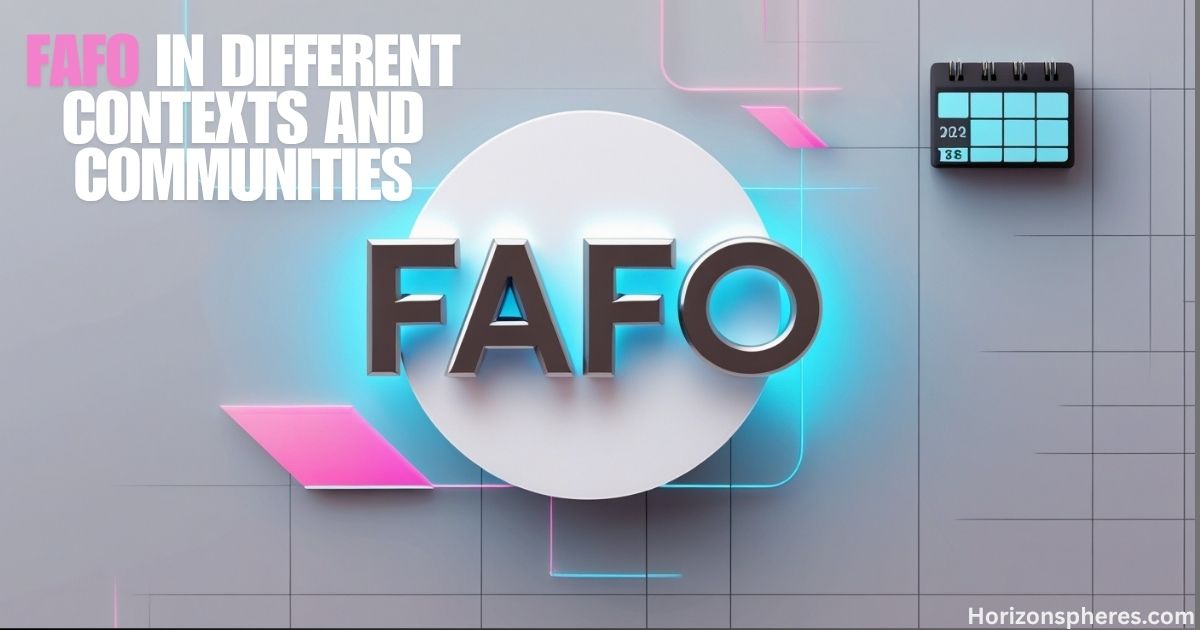Scrolling through TikTok comments, you’ve probably stumbled across “FAFO” dozens of times. What’s this mysterious acronym that’s everywhere from memes to heated Twitter debates? Should you worry if someone sends it your way?
FAFO is an acronym that stands for “Fuck around, find out.” It’s a slang term, often used online, that serves as a warning or expression of schadenfreude, indicating that someone will face the consequences of their actions. It essentially means that if you choose to act recklessly or without regard for potential negative outcomes, you will experience those negative consequences.
🔍 What Does FAFO Mean?

FAFO gained explosive popularity across social media platforms in 2024-2025, transforming from niche internet slang to mainstream digital vocabulary. This acronym represents more than just words—it embodies a cultural shift toward accountability.
The phrase “fuck around, find out” originated in online forums before TikTok and Twitter amplified its reach. Urban Dictionary entries for FAFO date back to 2018, but widespread adoption happened recently when consequence culture became trending topic material.
Breaking Down FAFO’s Digital Evolution
| Platform | Usage Context | Popularity Level |
| TikTok | Comments, video captions | Very High |
| Political debates, replies | High | |
| Discord | Gaming communities | Medium |
| Inappropriate usage | Very Low |
🧠 Understanding the Tone of FAFO
FAFO’s emotional undertones shift dramatically based on context and relationship dynamics. What does FAFO mean on TikTok versus professional settings creates vastly different interpretations that can make or break conversations.
The acronym carries three primary tones: jokingly defiant, dead serious, or sarcastically dismissive. Understanding these nuances prevents misunderstandings that could damage relationships or professional reputations in 2025’s digital landscape.
FAFO Tone Interpretation Guide
- Playful Warning: Used between close friends
- Serious Threat: Escalated conflict situations
- Sarcastic Dismissal: Passive-aggressive responses
- Boundary Setting: Establishing personal limits
⚠️ Why FAFO Is Not Always Appropriate
FAFO contains explicit language that violates most workplace communication standards and professional social media policies. HR departments across America increasingly monitor employee digital footprints, making inappropriate acronym usage career-limiting moves.
Age-appropriate considerations matter tremendously when FAFO appears in family group chats or educational settings. Parents discovering this slang in their teenager’s vocabulary often struggle with addressing its aggressive undertones appropriately.
More Post: Master FYP Meaning: Your Ultimate Guide to Unlocking Digital Success in 2025
Professional Consequences of FAFO Usage
| Setting | Risk Level | Potential Consequences |
| Work Email | Extreme | Disciplinary action |
| High | Professional reputation damage | |
| Family Chat | Medium | Generational conflict |
| Close Friends | Low | Misunderstood humor |
💡 11 Better Alternatives to FAFO (Based on Context and Tone)
Smart communicators choose alternatives that convey similar messages without FAFO’s aggressive baggage. These substitutes maintain effectiveness while preserving professional relationships and avoiding social media platform restrictions.
Context-appropriate alternatives range from workplace-friendly warnings to casual friendship banter. Selecting the right phrase depends on your audience, relationship dynamics, and desired outcome from the conversation.
Professional Workplace Alternatives
- “Actions have consequences” – Neutral, logical approach
- “I wouldn’t recommend that” – Professional dissuasion
- “Consider the implications” – Thoughtful warning
Casual Personal Alternatives
- “You’re playing with fire” – Friendly caution
- “Test me at your own risk” – Confident boundary
- “Let’s see how that works out” – Sarcastic challenge
Creative Conversational Options
- “Not the hill to die on” – Witty advisory
- “Keep going, don’t say I didn’t warn you” – Subtle caution
- “You’re about to cross a line” – Serious boundary
- “Push your luck and see what happens” – Playful edge
- “Consider this your final warning” – Formal escalation
More Post: Gyat Meaning: The Ultimate 2025 Guide Every Parent & Teen Must Read
✨ Choosing the Right Alternative Based on Tone
Tone matching requires reading conversational context, relationship history, and desired outcomes. Professional settings demand neutral language, while close friendships allow more creative expression without relationship damage.
Digital communication lacks vocal inflection and body language cues, making tone selection crucial for message clarity. Mismatched tone creates unnecessary conflict or weakens the intended impact of your message.
Situation-Specific Selection Guide
Workplace conflicts require professional neutrality using “Actions have consequences.” Friend banter allows playful warnings like “You’re playing with fire.” Serious boundaries demand assertive phrases such as “You’re about to cross a line.” Online strangers need neutral responses like “I wouldn’t recommend that” for appropriate communication.
📱 Why Understanding Slang Like FAFO Matters
Digital literacy in 2025 requires understanding evolving internet slang without necessarily adopting every trend. FAFO knowledge helps navigate online conversations, decode meme culture, and communicate across generational boundaries effectively.
Cross-generational communication improves when everyone understands current slang meanings. Parents, educators, and professionals benefit from staying informed about trending acronyms without compromising their communication standards.
Benefits of Slang Awareness
- Cultural relevance without inappropriate usage
- Misunderstanding prevention in digital spaces
- Inclusive communication across age groups
- Professional boundary maintenance
FAFO in Different Contexts and Communities

FAFO usage varies dramatically across professional sectors, military branches, and online communities. Law enforcement, political activists, and social media influencers each interpret this acronym differently, creating distinct communication patterns that reflect their unique cultural values and operational requirements.
Military and Law Enforcement Usage
FAFO military meaning aligns with consequence-based discipline systems used in armed forces training. Military personnel often encounter similar phrases emphasizing accountability and result-oriented thinking in high-stakes situations.
Law enforcement communities sometimes adopt FAFO language when discussing criminal justice outcomes, though official communications require more professional terminology for legal documentation and court proceedings.
Political and Social Media Contexts
FAFO political meaning emerged during 2024 election cycles when social media users warned about voting consequences and policy outcomes. Political commentators on TikTok and Twitter frequently use this acronym.
Political discourse increasingly features FAFO in grassroots movements and activist communities, though mainstream politicians avoid such explicit language in official statements and public appearances.
Regional and Demographic Variations
Geographic location and generational identity significantly influence FAFO adoption rates across America. Urban millennials embrace this slang differently than rural baby boomers, while East Coast and West Coast communities show distinct usage patterns reflecting their regional communication styles.
Geographic Usage Patterns
East Coast urban areas show higher FAFO adoption rates compared to Midwest and Southern regions. West Coast tech communities embrace internet slang faster, while rural areas lag behind in digital trend adoption.
Generational gaps create significant usage differences between Gen Z, Millennials, and older demographics. Gen Z treats FAFO as natural vocabulary, while Gen X and Baby Boomers often misunderstand its implications.
Cultural and Community Differences
| Demographic | Usage Rate | Context Preference |
| Gen Z (18-26) | Very High | TikTok, texting |
| Millennials (27-42) | High | Twitter, memes |
| Gen X (43-58) | Low | Rare usage |
| Baby Boomers (59+) | Very Low | Confusion/avoidance |
Digital Safety and FAFO Usage
FAFO transforms from harmless internet slang into a dangerous cyberbullying tool when misused by online predators and toxic users. Understanding warning signs, harassment patterns, and protection strategies helps users navigate digital spaces safely while avoiding FAFO-related threats and intimidation tactics.
Recognizing Toxic Applications
FAFO becomes problematic when used for cyberbullying, harassment, or intimidation tactics in online spaces. Toxic usage includes repeated targeting, threat escalation, and power imbalance exploitation.
Warning signs include persistent FAFO messaging, screenshot threats, doxxing implications, and coordinated harassment campaigns across multiple social media platforms.
Protection Strategies
- Document evidence through screenshots
- Report harassment to platform moderators
- Block aggressive users immediately
- Seek support from trusted friends or authorities
More Post: YNS Meaning in Text? Complete Guide to YNS Meaning and 11 Better Alternatives for 2025
Future of FAFO and Internet Slang Evolution
Internet slang lifecycles follow predictable cultural patterns, with FAFO currently peaking in mainstream adoption. Gen Alpha’s emerging digital vocabulary and platform algorithm changes will determine whether this acronym survives 2025 or joins forgotten internet trends in digital history.
Longevity Predictions
Internet slang lifespan depends on cultural relevance, platform algorithm support, and mainstream media adoption. FAFO’s staying power relies on continued consequence culture emphasis in American society.
Emerging alternatives already compete for attention as Gen Alpha develops distinct digital vocabulary. Language evolution suggests FAFO may peak in 2025 before gradual decline or transformation.
Educational Implications
Digital literacy curricula must address evolving slang while emphasizing appropriate communication standards. Schools and parents need updated strategies for internet language guidance without stifling authentic expression.
Frequently Asked Questions
Q: Why is FAFO trending?
Social media amplified consequence culture, making accountability phrases viral across platforms.
Q: What does the military term FAFO mean?
Military contexts use similar consequence-based language for disciplinary situations.
Q: What does FAFO mean in business?
Business rarely uses FAFO; professional alternatives convey consequences more appropriately.
Q: Where did the saying “FAFO” come from?
Internet forums popularized this phrase before mainstream social media adoption.
Q: What does FAFO parenting stand for?
Some parents use consequence-based approaches, though FAFO isn’t standard parenting terminology.
Conclusion
Understanding FAFO’s true meaning helps you communicate more effectively in 2025’s digital world. While this acronym carries consequence-focused messaging, choosing appropriate alternatives builds stronger relationships and maintains professionalism. Smart communicators balance authenticity with respect, creating inclusive conversations that connect rather than intimidate others online.










